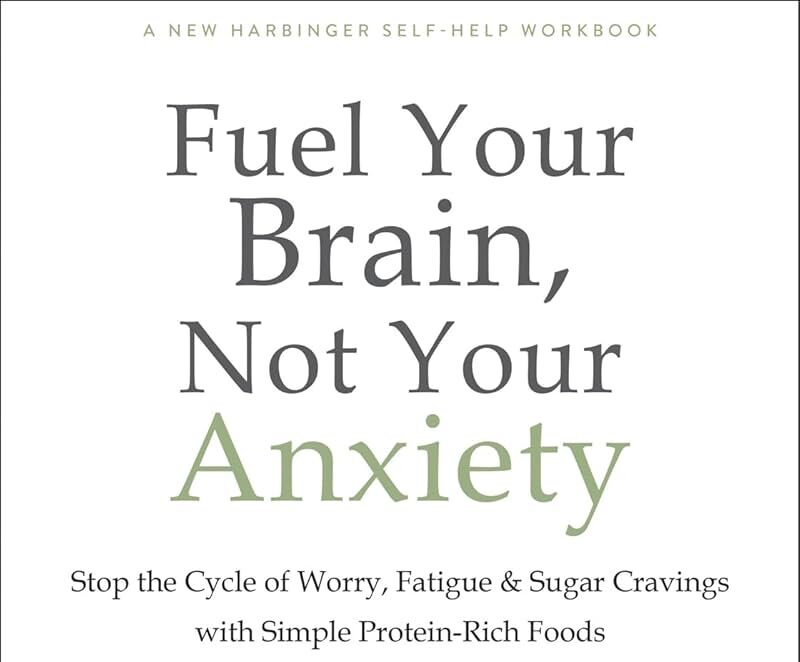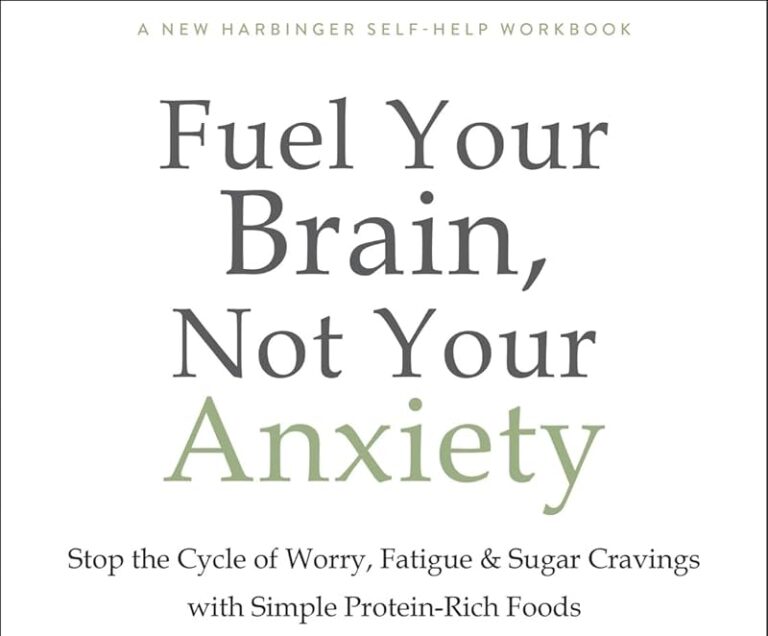
What Impacts Anxiety
Understanding what impacts anxiety and recognizing patterns of how the symptoms of anxiety show up in your life gives you a starting place for using food, sleep, exercise, and other tools to improve anxiety, worry, and fatigue.
Food, sleep, and exercise determine your body’s power supply. This means they can be significant drivers in your anxiety and fatigue; it also means they can be significant factors to reduce that anxiety and fatigue. The What Impacts Anxiety worksheet provides you with:
- A tool to increase awareness of the patterns of your anxiety. By identifying our patterns, we can often take action on our own behalf to address them before our anxiety accelerates and feels out of control.
- A reference point against which to measure the effect of experiments suggested in this workbook or other interventions, such as mindfulness, exposure therapy, medications, and observing anxiety levels in different environments or around different people.
- Documentation to share with medical care providers, if you’re seeing any, to help you get better care in the limited time you have with them.
You don’t have to use this tool as it’s presented; you can use the information outlined to ask yourself what is responsible for accelerating or calming your anxiety on any given day.
The What Impacts Anxiety Worksheet
Do you know what impacts your anxiety? The What Impacts Anxiety worksheet (also provided in the appendix and online at http://www.newharbinger.com/46233) will help you get more clear about this. We’ll go through each component and explain how it may be affecting your anxiety, worry, and fatigue.
What’s Going On?
Track what’s going on as often as makes sense for you; you don’t have to use all five columns provided. Examples might include meeting with your boss or client, transitioning from work to home, a phone call with a friend, or a tough conversation with a family member. The notes can be fairly basic; you can also use the back of the page if you need more space. The idea is to increase your awareness of what’s going on throughout the day—both the highs and the lows—so you can begin to see your patterns and how these may be influenced by both accelerators and resilience factors.Time of Day
Note the time of day that corresponds to what you entered for “What’s going on?”
Power Supply
It’s important to check in regularly on your power supply, as this is what’s helping your brain and mind stay calm and focused. Use the same scale from the power supply exercise in chapter 1: a scale of 1 to 10, with 1 being minimal energy and 10 being solid energy. Remember, a rating of 10 isn’t uncontrolled manic energy; rather, it means that you have the resources to respond to whatever opportunity arises, good or challenging.
Anxiety Level
In this section, note the level of anxiety you felt, using the scale provided. Is it low, medium, high? Identifying what is low, medium, and high anxiety is unique to each individual. Remember the symptoms you identified in the Snapshot of Anxiety Assessment: What symptoms show up first? What symptoms show up only when anxiety is really high? These may change over time or in different situations.
One challenge with anxiety is that generally, we observe it when it’s high and bothering us and we are uncomfortable; when it’s not high, we may not think about anxiety at all. Another challenge is anxiety’s lasting or residual effects. If we felt anxious at several points throughout the day, the different experiences aggregate in our memory, so the whole day gets labeled as anxious. This is why it’s important to note when you’re feeling anxious—so you can say, “I was anxious at lunchtime,” and the whole day doesn’t get colored as anxious. Fundamentally, the point of the exercise is to recognize that anxiety levels change throughout the day and week and to stay curious about what makes you feel better or worse.For some people it can take some practice to learn to observe anxiety and to be able to determine its level. If the 1-to-10 scale is too difficult to identify with, you can just use the labels low (managing anxiety with little effort), medium (needing to start using tools to manage anxiety), and high (feeling really uncomfortable). As Dan Siegel (2010) says, you have to “name it to tame it.”
What is your anxiety level?
- Low anxiety (levels 1–3) is when you’re mostly comfortable and are managing your anxiety with little effort. As you move from level 1 up to 3, you may be increasingly aware of it, but are still in control of how you’re managing yourself.
- Medium anxiety (levels 4–6) is when you feel more uncomfortable and the symptoms of anxiety are drawing your attention and may begin impacting the decisions and actions you take. This is when you need to start pulling out your tools to manage the anxiety. This worksheet helps you identify your triggers and when you need to be thinking about using those tools. It’s normal to have medium levels of anxiety off and on through life, such as when doing something new, before a presentation, or when returning to something that was really hard.
- High anxiety (levels 7–10) is when you start feeling really uncomfortable. This is where decision making and behavior are starting to be heavily influenced by the anxiety. The anxiety may no longer feel manageable, or you may feel like you’re just holding on. Left unchecked, you may experience a panic attack or total shutdown.
- Although you may be curious as to how your anxiety level compares with others’, this worksheet is intended to help you characterize your sense of it. Any comparison is to yourself, over time, and with experiments that you do to manage your anxiety better.
Anxiety Accelerators
Some things accelerate anxiety. Keeping track of your accelerators, especially alongside your anxiety levels across different times of day, can help you identify what is driving your patterns of anxiety. Accelerators include:
- Caffeine. You may have fatigue and need caffeine to function, but caffeine makes it easier for your brain to be anxious and harder to sleep. Caffeine helps you feel awake by increasing the hypervigilance of your brain. Hypervigilance is a key symptom of some forms of anxiety. If you’re prone to panic attacks, increasing the amount of information your brain is taking in might not be helpful. Stopping caffeine can keep anxiety from accelerating.
- Alcohol. Some people notice that, in the short term, a glass of alcohol helps reduce their anxiety. However, because alcohol disrupts your brain’s fuel supply, you can start to experience symptoms of anxiety four to six hours later. The use of alcohol to calm anxiety in the evening can cause early-morning insomnia, nightmares, higher anxiety levels in the mornings, and may also contribute to anxiety throughout the day (Lydon et al. 2016).
- Sugary foods. Your brain begins to think that everything will be okay 20 to 60 minutes after consuming sugar, thanks to the quick hit of glucose. However, if the sugar isn’t paired with protein, good fat, and healthy fiber, your blood glucose rapidly drops, and your anxiety starts to climb again within one and a half to three hours. We will discuss this phenomenon in more detail in chapter 3.
- Screen time. Spending more than two hours a day in front of a screen outside of work or school will increase anxiety, depression, and fatigue (Hoare et al. 2017; Madhav et al. 2017).
- Stressful day. We all understand how stress increases anxiety: as the things that trigger your anxiety pile up—long work hours, meetings, appointments, childcare—the symptoms you feel become worse and worse. During these busy days, your brain will need more fuel to manage the stress, your anxiety, and sugar cravings.
Daily Practices
What and when you eat, movement and exercise, sleep, and supportive relationships are all important for maintaining your power supply and reducing anxiety. Conversely, not eating or eating foods without protein, not moving or exercising, not getting at least seven hours of sleep, and having to deal with unsupportive relationships can make managing anxiety more challenging. For your daily practices, just note what you’re currently doing or not doing, without judgment. Do you notice any patterns that relate to your anxiety levels? We’ll go into more de
What and when you eat, movement and exercise, sleep, and supportive relationships are all important for maintaining your power supply and reducing anxiety. Conversely, not eating or eating foods without protein, not moving or exercising, not getting at least seven hours of sleep, and having to deal with unsupportive relationships can make managing anxiety more challenging. For your daily practices, just note what you’re currently doing or not doing, without judgment. Do you notice any patterns that relate to your anxiety levels? We’ll go into more detail about what might be driving these patterns in later chapters and will suggest achievable experiments for you to try, which may improve your anxiety, worry, and fatigue.
“Resilience factors” are additional things that help reduce anxiety. Keeping track of your resilience factors, especially alongside your anxiety levels across different times of day, can help you identify what may reduce your anxiety. In the worksheet, we’ve listed some common resilience factors. Maybe you have tried these or others. There are entire books written on each of these if you want to learn more.
Now that you know how the What Impacts Anxiety worksheet works, it’s time to begin using it. When is a good day for you to start tracking the accelerators and resilience factors of your anxiety? Start on a day that might cause moderate anxiety, instead of a day that you anticipate will be extra challenging. This way, you won’t be adding an additional task on an overwhelming day. We suggest using the worksheet to track your anxiety for three days.
A Visit with Extended Family
A few weeks ago Taylor spent a long weekend with family. Having worked with Kristen for some time now, she loaded up on protein snacks and protein-based ingredients for meals. Anticipating that this would likely be a stressful weekend, she decided to bring along the What Impacts Anxiety worksheet and give it a try.
Taylor started off thinking she would check in five times throughout the day, at regular intervals, but it quickly became clear that wasn’t realistic given the setting. Still, she found that having started. Taylor started off thinking she would check in five times throughout the day, at regular intervals, but it quickly became clear that wasn’t realistic given the setting. Still, she found that having started with this intention kept her checking in with herself much more regularly than she would have otherwise. Taylor generally jotted notes on the worksheet at the beginning and end of each day, noting the ups and downs as she remembered them. Being more aware helped her to know when to pull out her “tools,” like taking a quick time-out or grabbing some beef jerky or a hard-boiled egg. She also made a point of going to bed at her normal time (ten to eleven o’clock), even though everyone else was staying up until 2:00 or 3:00 a.m. Taylor realized on the first morning that this had an added benefit of some quiet time, as she also woke up a bit earlier than everyone else.
Although there were a few acute stress points throughout the weekend, Taylor’s anxiety over the weekend was lower than during previous visits. As she drove home, she realized that she didn’t need a day off from work to recover the way she did after previous family gatherings
Chapter Summary
Hopefully, after you’ve used the What Impacts Anxiety worksheet for a brief period of time, you now have a better sense of what’s influencing your anxiety. The What Impacts Anxiety worksheet is available in the appendix and for download at http://www.newharbinger.com/46233.
Next we’ll explain why the food you eat is such an important factor in your experience of anxiety, as an accelerator and a resilience factor. Armed with this knowledge, you’ll be able to begin using food as a tool to manage anxiety.


